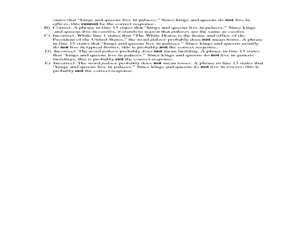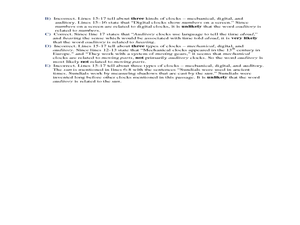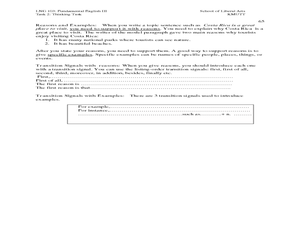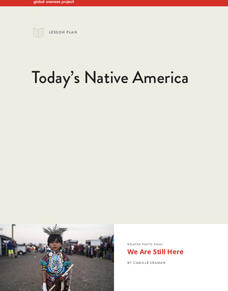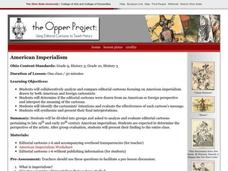Curated OER
Beginning Critical Reading - Paper
In these critical reading worksheets, students read the paragraphs about paper. Students answer 3 critical reading questions about the passage.
Curated OER
Beginning Critical Reading - Soaps and Detergents
In these critical reading worksheets, students read the short story about soaps and detergents. Students then answer 3 critical reading questions about the passage.
Curated OER
Beginning Critical Reading - The White House
In these critical reading worksheets, students read the story about The White House. Students then answer 3 critical reading questions about the passage.
Curated OER
Intermediate Critical Reading - Clocks
In these critical reading worksheets, learners read the short story about clocks. Students then answer 3 critical reading questions about the passage.
Curated OER
Intermediate Critical Reading - Hybrid Vehicles
In these critical reading worksheets, learners read the story about hybrid vehicles. Students then answer 4 critical reading questions.
Curated OER
Beginning Critical Reading - The Flu
In these critical reading worksheets, students read the story about the flu. Students answer 3 questions about the story and their explanations.
Curated OER
Governance
Third graders participate in decision-making situations. In this social studies lesson students make connections between rules and laws and the purposes for those rules and laws. Students use critical and creative thinking skills to...
Curated OER
Stating Reasons and Giving Examples
For this paragraph construction worksheet, students read a model paragraph regarding Costa Rica. Students respond to 10 questions regarding the structure of the paragraph.
Curated OER
Critical Thinking & Writing: Brainstorming
Have your young writers organize their thoughts before writing. They generate ideas through various brainstorming activities prior to writing a mock feature news story for USA Today. A series of USA Today articles debating the level of...
The New York Times
Reader Idea | Thinking Like a Historian About Current World Events
Check out this fantastic research project where learners work to see the modern world through the eyes of a historian and analyze a contemporary event of their choice. An in-depth reflection on the project is given by the project...
National Endowment for the Humanities
Dostoevsky's Crime and Punishment
Pain and suffering do not have to be inevitable in a study of Crime and Punishment. A carefully scaffolded lesson introduces readers to the divided natures of the characters in Fyodor Dostoevsky's complex novel. Groups use the provided...
Curated OER
Writing Exercises: Economic and Social Revolutions IV
Any revolution is going to impact both society and economy. The class works to grasp the effect of industrialization on the environment, government, and politics. They respond to three critical thinking questions which require them to...
Curated OER
Are Antismoking Ads Effective?
Are the anti-smoking ads put out by the federal government effective? This question is posed to your critical thinkers. They'll read excerpts from a New York Times article and then compose thoughtful blog responses to four related...
Encyclopedia Britannica
Candidate Position History Research
Climate change. Assault weapons ban. Death penalty. And the list goes on. So many issues are part of a US presidential election that it can be hard to determine a candidate's position on a particular topic and whether their position has...
Encyclopedia Britannica
Election Issue Comparison Chart
As part of a study of the issues raised in the 2020 presidential election campaign, class members investigate and then create a pro-con comparison chart that reveals each candidate's position on a variety of issues.
Teaching Tolerance
Thanksgiving Mourning
Two primary sources, a speech, and an article provide tweens and teens with different perspectives of the American Thanksgiving holiday. After analyzing Wamsutta James' suppressed speech and Jacqueline Keeler's article, class members use...
Newseum
When Tragedy Hits — Role-Playing a Breaking News Story
Young journalists engage in a role-playing exercise that asks them to consider the journalism and ethical issues raised by the coverage of the mass shootings at Virginia Tech on April 16, 2007. Pupils play the role of either a reporter...
Newseum
Is This Story Share-Worthy?
Young journalists use a "Is This Story Share-Worthy?" flowchart graphic to decide whether a story is worth sharing online. Instructors provide groups with fake news, poor quality stories, opinion pieces, biased news, and high-quality...
Global Oneness Project
Today’s Native America
The 2016-2017 protests over the Dakota Access Pipeline (DAPL) motivated Camille Seaman to create "We Are Still Here," a photo essay featuring portraits of contemporary Native Americans who protested the pipeline. This eight-page packet,...
Curated OER
Lesson 12: What Reasonable Conclusions are Possible?
Oftentimes, we jump to conclusions when we are given a limited amount of information. Take a look at reasonable conclusions with your communications studies class. If-clauses, dichotomous thinking, and assumptions are all covered with...
Learning for Justice
Marian Wright Edelman
Marian Wright Edelman's 2014 Commencement Speech at Lewis and Clark College serves to inspire young scholars to investigate a problem in their community, to determine why the problem is important, and then to develop a plan for one thing...
Curated OER
The Choking Dog: Critical Reading Exercise
In this critical reading exercise, students read a selection entitled "The Choking Dog." Students answer ten multiple choice questions about the selection.
Curated OER
American Imperialism
Critical analysis skills can be built in a variety of ways. Using editorial cartoons (both domestic and foreign) learners will consider how American Imperialism was perceived during the late 19th century. Critical thinking questions,...
Curated OER
French Revolution: The Declaration of Pillnitz
Answering document-based questions increases critical analysis and comprehension skills. The class reads a passage from The Declaration of Pillnitz then answers three critical thinking questions.




